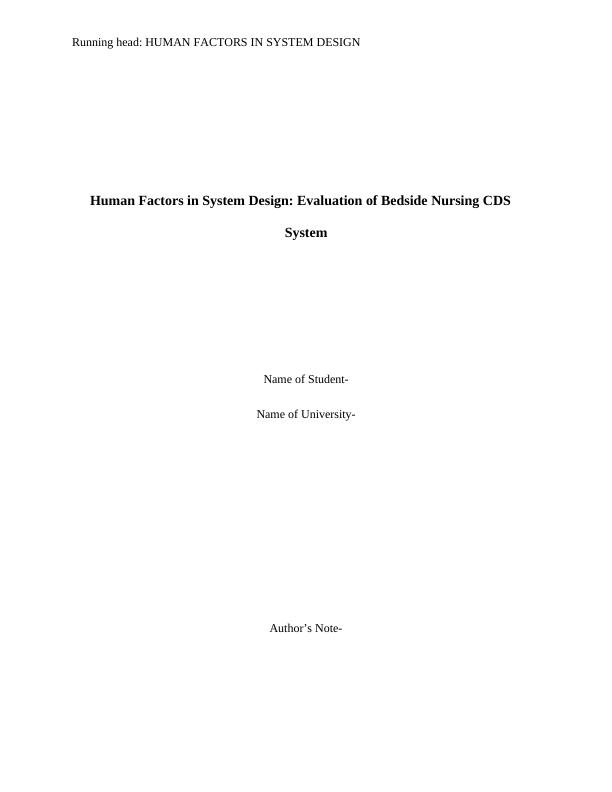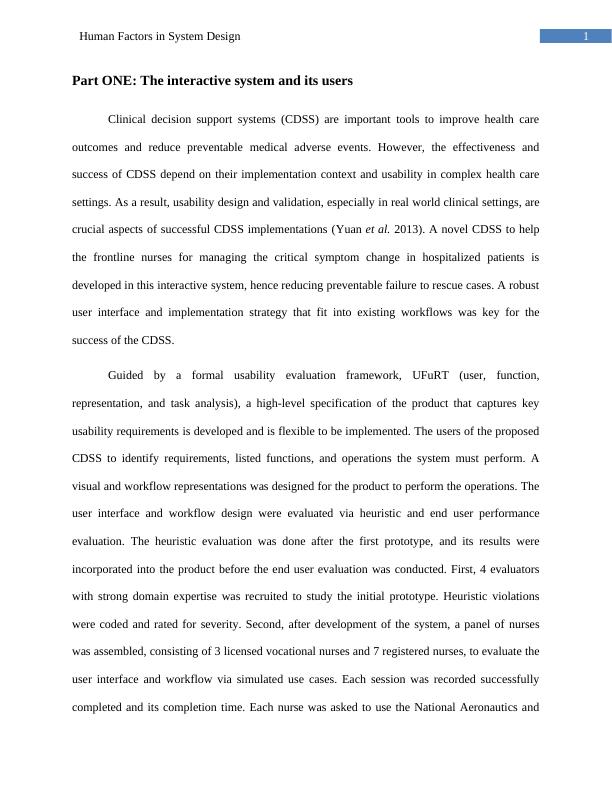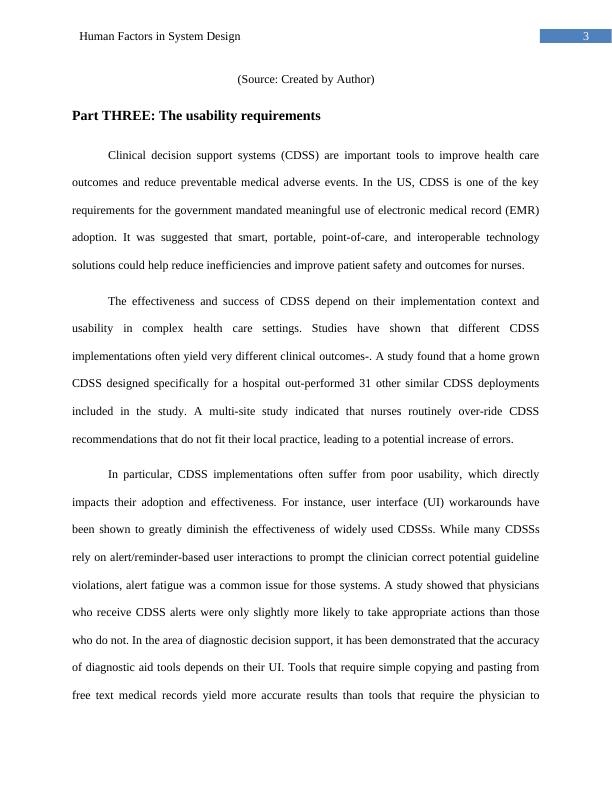Human Factors in System Design
Added on 2023-04-07
19 Pages4183 Words144 Views
Running head: HUMAN FACTORS IN SYSTEM DESIGN
Human Factors in System Design: Evaluation of Bedside Nursing CDS
System
Name of Student-
Name of University-
Author’s Note-
Human Factors in System Design: Evaluation of Bedside Nursing CDS
System
Name of Student-
Name of University-
Author’s Note-

1Human Factors in System Design
Part ONE: The interactive system and its users
Clinical decision support systems (CDSS) are important tools to improve health care
outcomes and reduce preventable medical adverse events. However, the effectiveness and
success of CDSS depend on their implementation context and usability in complex health care
settings. As a result, usability design and validation, especially in real world clinical settings, are
crucial aspects of successful CDSS implementations (Yuan et al. 2013). A novel CDSS to help
the frontline nurses for managing the critical symptom change in hospitalized patients is
developed in this interactive system, hence reducing preventable failure to rescue cases. A robust
user interface and implementation strategy that fit into existing workflows was key for the
success of the CDSS.
Guided by a formal usability evaluation framework, UFuRT (user, function,
representation, and task analysis), a high-level specification of the product that captures key
usability requirements is developed and is flexible to be implemented. The users of the proposed
CDSS to identify requirements, listed functions, and operations the system must perform. A
visual and workflow representations was designed for the product to perform the operations. The
user interface and workflow design were evaluated via heuristic and end user performance
evaluation. The heuristic evaluation was done after the first prototype, and its results were
incorporated into the product before the end user evaluation was conducted. First, 4 evaluators
with strong domain expertise was recruited to study the initial prototype. Heuristic violations
were coded and rated for severity. Second, after development of the system, a panel of nurses
was assembled, consisting of 3 licensed vocational nurses and 7 registered nurses, to evaluate the
user interface and workflow via simulated use cases. Each session was recorded successfully
completed and its completion time. Each nurse was asked to use the National Aeronautics and
Part ONE: The interactive system and its users
Clinical decision support systems (CDSS) are important tools to improve health care
outcomes and reduce preventable medical adverse events. However, the effectiveness and
success of CDSS depend on their implementation context and usability in complex health care
settings. As a result, usability design and validation, especially in real world clinical settings, are
crucial aspects of successful CDSS implementations (Yuan et al. 2013). A novel CDSS to help
the frontline nurses for managing the critical symptom change in hospitalized patients is
developed in this interactive system, hence reducing preventable failure to rescue cases. A robust
user interface and implementation strategy that fit into existing workflows was key for the
success of the CDSS.
Guided by a formal usability evaluation framework, UFuRT (user, function,
representation, and task analysis), a high-level specification of the product that captures key
usability requirements is developed and is flexible to be implemented. The users of the proposed
CDSS to identify requirements, listed functions, and operations the system must perform. A
visual and workflow representations was designed for the product to perform the operations. The
user interface and workflow design were evaluated via heuristic and end user performance
evaluation. The heuristic evaluation was done after the first prototype, and its results were
incorporated into the product before the end user evaluation was conducted. First, 4 evaluators
with strong domain expertise was recruited to study the initial prototype. Heuristic violations
were coded and rated for severity. Second, after development of the system, a panel of nurses
was assembled, consisting of 3 licensed vocational nurses and 7 registered nurses, to evaluate the
user interface and workflow via simulated use cases. Each session was recorded successfully
completed and its completion time. Each nurse was asked to use the National Aeronautics and

2Human Factors in System Design
Space Administration (NASA) Task Load Index to self-evaluate the amount of cognitive and
physical burden associated with using the device.
Users of the proposed CDSS were members of the clinician team responsible for rescuing
patients in the hospital. They included floor nurses, RRT nurses, and physicians. The user roles
described in this section were based on interviews with hospital clinicians.
Part TWO: The use cases
Figure 1: Use case for the System
Space Administration (NASA) Task Load Index to self-evaluate the amount of cognitive and
physical burden associated with using the device.
Users of the proposed CDSS were members of the clinician team responsible for rescuing
patients in the hospital. They included floor nurses, RRT nurses, and physicians. The user roles
described in this section were based on interviews with hospital clinicians.
Part TWO: The use cases
Figure 1: Use case for the System

3Human Factors in System Design
(Source: Created by Author)
Part THREE: The usability requirements
Clinical decision support systems (CDSS) are important tools to improve health care
outcomes and reduce preventable medical adverse events. In the US, CDSS is one of the key
requirements for the government mandated meaningful use of electronic medical record (EMR)
adoption. It was suggested that smart, portable, point-of-care, and interoperable technology
solutions could help reduce inefficiencies and improve patient safety and outcomes for nurses.
The effectiveness and success of CDSS depend on their implementation context and
usability in complex health care settings. Studies have shown that different CDSS
implementations often yield very different clinical outcomes-. A study found that a home grown
CDSS designed specifically for a hospital out-performed 31 other similar CDSS deployments
included in the study. A multi-site study indicated that nurses routinely over-ride CDSS
recommendations that do not fit their local practice, leading to a potential increase of errors.
In particular, CDSS implementations often suffer from poor usability, which directly
impacts their adoption and effectiveness. For instance, user interface (UI) workarounds have
been shown to greatly diminish the effectiveness of widely used CDSSs. While many CDSSs
rely on alert/reminder-based user interactions to prompt the clinician correct potential guideline
violations, alert fatigue was a common issue for those systems. A study showed that physicians
who receive CDSS alerts were only slightly more likely to take appropriate actions than those
who do not. In the area of diagnostic decision support, it has been demonstrated that the accuracy
of diagnostic aid tools depends on their UI. Tools that require simple copying and pasting from
free text medical records yield more accurate results than tools that require the physician to
(Source: Created by Author)
Part THREE: The usability requirements
Clinical decision support systems (CDSS) are important tools to improve health care
outcomes and reduce preventable medical adverse events. In the US, CDSS is one of the key
requirements for the government mandated meaningful use of electronic medical record (EMR)
adoption. It was suggested that smart, portable, point-of-care, and interoperable technology
solutions could help reduce inefficiencies and improve patient safety and outcomes for nurses.
The effectiveness and success of CDSS depend on their implementation context and
usability in complex health care settings. Studies have shown that different CDSS
implementations often yield very different clinical outcomes-. A study found that a home grown
CDSS designed specifically for a hospital out-performed 31 other similar CDSS deployments
included in the study. A multi-site study indicated that nurses routinely over-ride CDSS
recommendations that do not fit their local practice, leading to a potential increase of errors.
In particular, CDSS implementations often suffer from poor usability, which directly
impacts their adoption and effectiveness. For instance, user interface (UI) workarounds have
been shown to greatly diminish the effectiveness of widely used CDSSs. While many CDSSs
rely on alert/reminder-based user interactions to prompt the clinician correct potential guideline
violations, alert fatigue was a common issue for those systems. A study showed that physicians
who receive CDSS alerts were only slightly more likely to take appropriate actions than those
who do not. In the area of diagnostic decision support, it has been demonstrated that the accuracy
of diagnostic aid tools depends on their UI. Tools that require simple copying and pasting from
free text medical records yield more accurate results than tools that require the physician to

End of preview
Want to access all the pages? Upload your documents or become a member.
Related Documents
Human Factors in System Design: Evaluation of Bedside Nursing CDS Systemlg...
|20
|4400
|487
Human Factors in System Design: Usability Testing of a Complex CDS Tool in an Emergency Departmentlg...
|14
|3285
|152
Clinical Decision Support System (CDSS) | Reportlg...
|4
|735
|24
Clinical Decision Support Systemslg...
|3
|743
|18
Assignment on e-Clinical Workslg...
|6
|1181
|31
(PDF) Human Factors in Systems Designlg...
|13
|3773
|71
